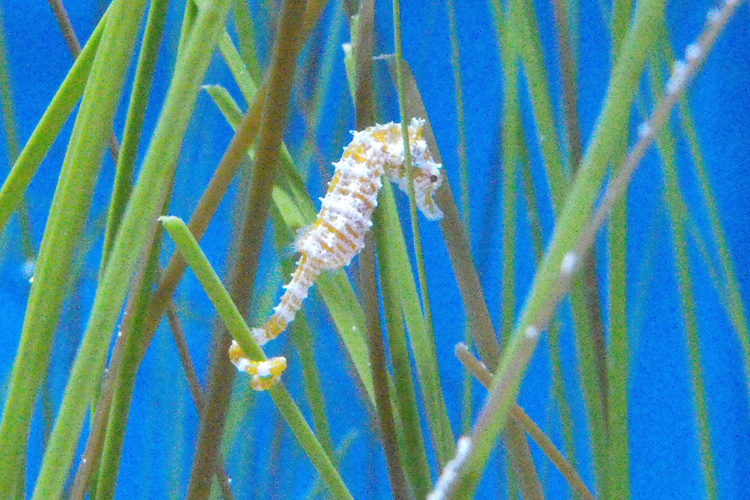
by Rick O'Connor | Nov 6, 2020
Seagrasses have been described as the “nursery of the sea”. Studies show that up to 90% of the commercially valuable fin and shellfish species spend part, or all, of their lives in these submerged meadows. As you can imagine, these grasses must grow in clear, relatively shallow waters – so they are more inshore. You might also imagine that most of the fish living here are going to be small. There are the larger predators in this grassy world, but most are going to be small enough to hide amongst the blades.
These inshore seagrass meadows not only provide hiding places but provide food as well. Interestingly, most do not feed on the grass directly, but rather the tiny plants and animals that are attached to the blades – what are called epiphytes and epizoids. Those that feed on these are then preyed upon by slightly large creatures until we find the larger apex predators – like the speckled trout.
Many of those who reside here are specialist in camouflage and mimicry, and others might be ones who actually live in the sand bordering the edge of the meadows – waiting for a chance to pounce on unsuspecting food. Let’s meet a few of these interesting fish.
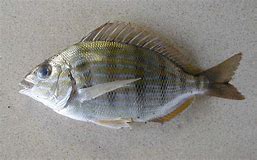
Photo: Nicholls State University
Pinfish
You are at the beach for a day of fun and sun. You enter the water of Santa Rosa Sound to play at the edge of the seagrass bed, or maybe to snorkel and explore it. As you stand on the sand you feel little nips at your ankles and immediately think – CRAB! But you would be wrong. As you look closer you will see it came from a small fish – and the more you stir the sand, more of these small fish arrive. They are probably feeding on the small invertebrates that are stirred up from your movement, but they periodically nip at you as well.
This small fish is a very common member of the inshore fish community known as the pinfish. They are members of the Porgy family, related to sheepshead, and have incisor teeth for crushing the shells of their prey. Most locals are first introduced to them as a kid while fishing. They seem to bite, or steal, any bait you put on. Most often used as bait themselves, they are actually edible – but you need one of the large ones to have a meal. They get their common name from the sharp spines of their dorsal fin. When snorkeling in the grassbeds you will find they are the most common fish there.
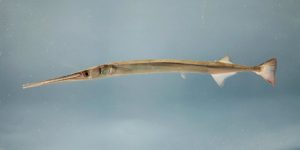
Photo: USGS
Needlefish
These guys look scarier than they are. Long skinny fish with long skinny snouts that hold long skinny teeth. They resemble barracuda and have the look as if they could attack and do some damage – but they are harmless, unless you catch one in a net, then they will swing their long skinny heads towards your hand for snip.
These small predators travel above the grassbeds looking for potential prey hiding among. Small juvenile fish seem to be what they want. Though often just referred to as “needlefish”, there are actually four species, but they are hard to tell apart.
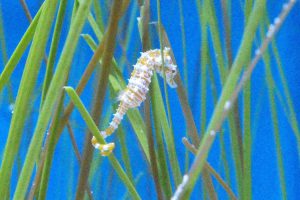
Photo: NOAA
Seahorses
These are captivating fish, and very hard to find as they blend in so well, but they are there – along with their close cousins the pipefish. It seems hard to call it a fish at all – it certainly does not look like one. Swimming vertically in the water, no tail to speak of, they seem like a creature in their own group. But they are fish. The scales are fused into an armor plating and they do have both gills and fins – characteristics of fish. They will use their prehensile tail to grab onto a grass blade, hanging there waiting for tiny shrimp to swim by which they inhale using a vacuum like motion with their tube-shaped mouths.
Pipefish resemble seahorses but are elongated, with a distinct fin for a tail, and swim horizontally as most fish do. They will turn vertically in the grass to appear to be a blade themselves and hunt similar prey as their seahorse cousins.
A well-known characteristic of this group is the fact that the males carry the fertilized eggs – not the females. Males can be identified by the brood sac on their ventral side and they may carry up to 80 eggs. The eggs hatch within the pouch and the young are born alive.
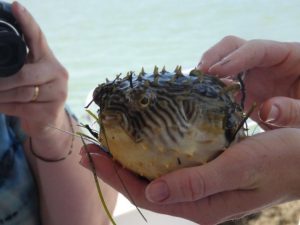
Photo: NOAA
Puffers
This group of fish are famous for their ability to “blow up”, or inflate like a balloon, when threatened. Kids love to play with them and get a kick out of watching them inflate. These are round bodied – slow moving fish, which is one reason they inflate. It does not matter if you can catch them, you cannot swallow them if you do!
There are actually two different families of “blowfish”. The true puffers are smaller (3-12 inches), have tubercles on their bodies instead of long spines, and the teeth in the upper and lower jaw have a space forming four teeth (two on the top jaw, two on the bottom) – giving them their family name “tetradontidae”. The “burrfish” are larger in size (1-2 feet), have long spines on the body, and no median in the teeth – so only one tooth on the top jaw, one on the bottom – “diodontidae”.
The most common one found is the striped burrfish. The big boy of the group – the 2-foot porcupine fish – is rare in the northern Gulf and prefers the reefs of the open sea to grassbeds.
When threatened they will inflate with water (or air) and try to continue swimming. After the danger has passed, they will deflate and go about their merry way. There are stories about their flesh being poisonous and dangerous to eat – it is true. The compound they produce is one of the more toxic found in the fish world. Though there are certified chefs around the world who can safely clean them, it is not recommended you eat these.
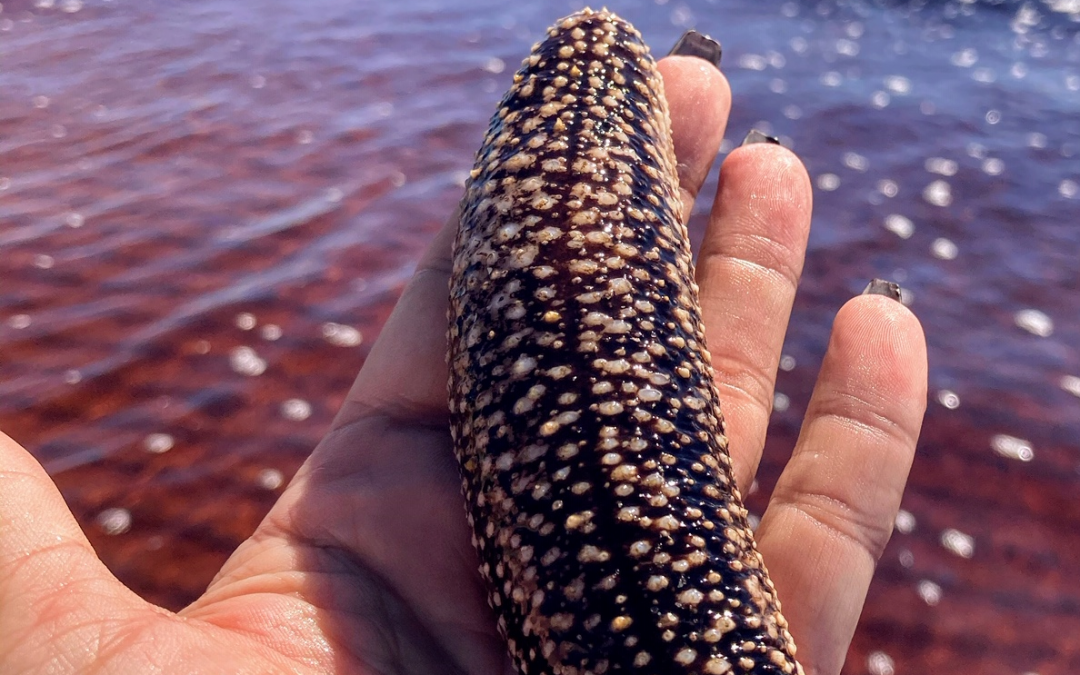
by Sheila Dunning | Oct 16, 2020
That’s the question from a recent group exploring what washed up on the beach after Hurricane Sally.
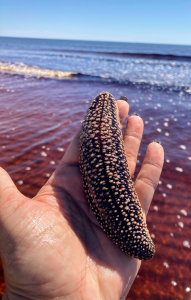
Sea Cucumber
Photo by: Amy Leath
They have no eyes, nose or antenna. Yet, they move with tiny little legs and have openings on each end. Though scientists refer to them as sea cucumbers, they are obviously animals. Sea cucumbers get their name because of their overall body shape, but they are not vegetables.
There are over 1,200 species of sea cucumbers, ranging in size from ¾“ to more than 6‘ long, living throughout the world’s ocean bottoms. They are part of a larger animal group called echinoderms, which includes starfish, urchins and sand dollars. Echinoderms have five identical parts to their bodies. In the case of sea cucumber, they have 5 elongated body segments separated by tiny bones running from the tube feet at the mouth to the opening of the anus. These squishy invertebrates spend their entire life scavenging off the seafloor. Those tiny legs are actually tube feet that surround their mouth, directing algae, aquatic invertebrates, and waste particles found in the sand into their digestive tract. What goes in, must come out. That’s where it becomes interesting.
Sea cucumbers breathe by dilating their anal sphincter to allow water into the rectum, where specialized organs referred to as respiratory trees (or butt lungs) extract the oxygen from the water before discharging it back into the sea. Several commensal and symbiotic creatures (including a fish that lives in the anus, as well as crabs and shrimp on its skin) hang out on this end of the sea cucumber collecting any “leftovers”.
But, the ecosystem also benefits. Not only is excess organic matter being removed from the seafloor, but the water environment is being enriched. Sea cucumbers’ natural digestion process gives their feces a relatively high pH from the excretion of ammonia, protecting the water surrounding the sea cucumber habitats from ocean acidification and providing fertilizer that promotes coral growth. Also, the tiny bones within the sea cucumber form from the excretion of calcium carbonate, which is the primary ingredient in coral formation. The living and dying of sea cucumbers aids in the survival of coral beds.
When disturbed, sea cucumbers can expose their bony hook-like structures through their skin, making them more pickle than cucumber in appearance. Sea cucumbers can also use their digestive system to ward of predators. To confuse or harm predators, the sea cucumber propels its toxic internal organs from its body in the direction of the attacker. No worries though. They can grow them back again.
Hurricane Sally washed the sea cucumbers ashore so you could learn more about the creatures on the ocean floor. Continue to explore the Florida panhandle outdoor.
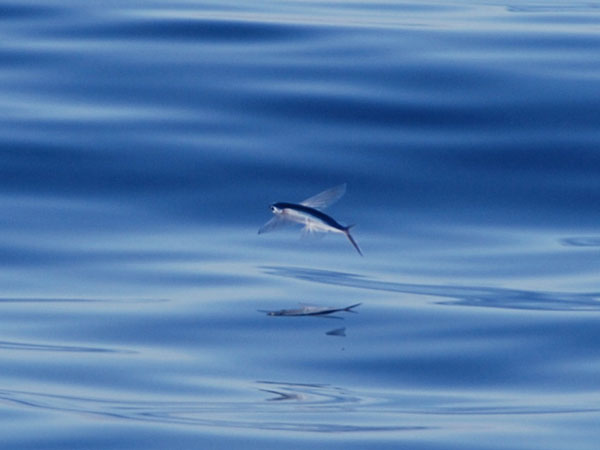
by Rick O'Connor | Sep 11, 2020
There is a lot of blue out there… a whole lot of blue. Miles of open water in the Gulf with nowhere to hide… except amongst yourselves. Their blue colored bodies, aerodynamically shaped like bullets with stiff angular fins, can zip along in this vast blue openness in large schools. Their myoglobin rich red muscle increases their swimming endurance – they can travel thousands of miles without tiring. Some species are what we call “ram-jetters”, fish that basically do not stop swimming – roaming the “big blue” looking for food and avoid being eaten, following the warm currents in search of their breeding grounds.
The open water is a place for specialists. Most of these fish have small, or no scales, to reduce frictional drag. They have a well-developed lateral line system so when a member of the school turns, the others sense it and turn in unison – just as the four planes in the US Navy Blue Angels delta do – perfect motion.
Many are built for speed. Sleek bodies with sharp angular fins and massive amounts of muscle / body mass, some species can reach speeds close to 70 mph – some can “fly”. There are fewer species who can live here, as opposed to the ocean floor, but those who do are amazing – and some of the most prized commercial and recreational fishing targets in the world. Let’s meet a few of them.
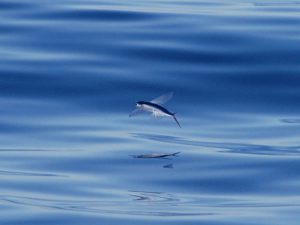
Flying fish do not actually “fly”, they are gliders using their long pectoral fins.
Photo: NOAA
Flying Fish
First, they do not actually fly – they glide. These tube-shaped speedy fish have elongated pectoral fins, reaching half the length of their bodies. The two lobes of their forked tail are not the same length – the lower lobe being longer. Using this like a rudder, they gain speed near the surface and, at some point, leap – extend the large pectoral fins, and glide above the water – sometimes up to 100 yards. As you might guess, this is to avoid the sleek speedy open water predators coming after them. You might also imagine that they, and their close cousins the half-beaks, are popular bait for the bill fishermen seeking those predators.
There are eight species of these amazing fish in the Gulf of Mexico ranging in size from 6-16 inches. Most are oceanic – never coming within 100 miles of the coast, but a few will, and can, be seen even near the pass into Pensacola Bay.
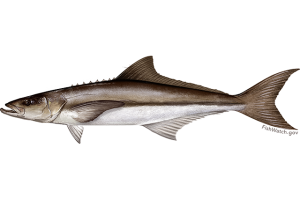
The cobia – also known as the ling, lemonfish, and sergeant fish, is a migratory species moving through our area in the spring.
Image: NOAA
Cobia
This is one of the migrating fish local anglers gear up for every year – the cobia run. When the water turns from 60° to 70°F in the spring – the cobia moves up the coastline heading from east to west. They have many different common names along the Gulf Coast. Ling, Cabio, Lemonfish, and Sergeant fish have all been used for this same animal. This is one reason biologists use scientific names – Rachycentron canadum in this case. That way we all know we are talking about the same fish. Whatever you call it, it is popular with the anglers and there is nothing like a fresh cobia sandwich – try one!
They can get quite large – 5 feet and up to 100 pounds – and resemble sharks in the water, sometimes confused with them. They seem to like drifting flotsam, where potential prey may hangout, and fishermen will toss their baits all around their schools trying to get them to take. At times, fishermen have confused sea turtles with cobia and have accidentally snagged them – only to release it, though it is a workout to do so, and they try to avoid it.
Cobia are in a family all their own. Their closest relatives are the remoras, or sharksuckers, which sometimes attach to them. They travel all over the Gulf and Atlantic Ocean.
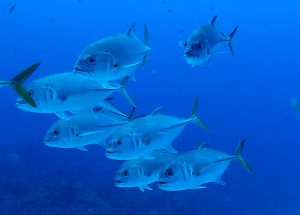
Jacks have the sleek, fast design of the typical open water marine fish.
Photo: NOAA
Jacks
This is the largest open water family of fish I the northern Gulf – with 24 species. Not all jacks are open water, many are found on reefs and in estuaries. But these are aerodynamic shaped fish, with small scales and angular fins, and built for the open water environment. They vary in size, ranging from less than one foot, to over three. This group is identified by the two extended spines just in front of their anal fin. Several species – such as the amberjacks, pompano, and almaco jacks – are prized food fish. Others – like the jack crevalle and the blue runner (hardtail) – are just fun to catch, putting up great fights.
They are schooling fish and often associated with submerged wrecks and reefs, where prey can be found. The black and white pilot fish is called this because mariners would see them swimming in front of sharks – “piloting” them through the ocean. They are open water jacks but are more tropical and accounts in our area are rare.
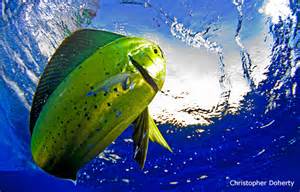
The colors of the mahi-mahi are truly amazing.
Photo: National Wildlife Federation
Mahi–Mahi
This is the Hawaiian term for a fish called the dolphin (Coryphaena hippurus). You can probably guess why they prefer to call it by its Hawaiian name. It is a popular food fish, and to have “dolphin” on the menu – or to say “hey, we’re going dolphin fishing – want to come?” would raise eyebrows – and have.
The Mexicans call it “dorado”, and that term is used locally as well. Either name – it is an amazing fish. With the bull-shaped forehead of the males – they are sometimes referred to as the “bull-dolphin”. Their colors, and color changing, is amazing to see. Some biologists believe this may be some form of communication between members, don’t know, but the brilliant greens, blues, and yellows are amazing to see. They lose these colors shortly after death, so you must see it to believe it – or find one of the popular fish t-shirts.
Like jacks, dolphin like to hang around flotsam, or large schools of baitfish, looking for prey. As with many other open water predators, they will sometimes work in a team to scare, and scatter, individuals from the safety of their school. There are only two species in this family, and both are prized for their taste.

The Striped Mullet.
Image: LSU Extension
Mullet
This is not one you would typically call an “open water” fish. But in the nearshore Gulf and estuaries, they are more open water than bottom dwellers – though they do feed off the bottom. Sleek bodied, forked tail, angular fins, they have what it takes to be a fast swimmer. Though they do not “fly” as the flying fish do, they do leap out of the water. Many visitors hanging out around the Sound will hear a fish splash and immediately ask “what kind of fish was that?” Many locals will respond without looking up – “it was a mullet” – and they are probably right.
This brings up the age-old question… why do mullet jump? This was once asked of a marine biology professor. He paused… thought… and responded saying “for the same reasons manta rays jump”. That was it… another long pause. Finally, the students “took the bait” – “Okay, why do manta rays jump?”. The professor replied, “we don’t know”. So, there you go.
Another interesting thing about this fish is its wide tolerance of salinity. Mullet have been found in freshwater rivers and springs and the hypersaline lagoons of south Texas – they truly don’t care.
Locally they are popular food fish, and support a large commercial fishery in Florida, but in other parts of the Gulf not so much. It has to do with their environment and what they are feeding on. In muddier portions of the Gulf (or our bay for that matter) they have an oily taste and locals there call the “trash fish”. Even hearing that locals here eat them “grosses” them out. Local respond by giving it a more “high end” name – the Mulle (spoken with a French accent). This is actually the Cajun term for the fish. And let’s step it up a notch by adding that many locals eat mullet row – the eggs. Yea… getting hungry right? One of the popular cable food shows came here to try mullet roe. They said on a scale of 1 to 10, they give it a -4.
All that said, it is a local icon – with seafood stores selling “In Mullet We Trust” t-shirts, and the popular “Mullet Toss” event held every year on Perdido Key. It is a COOL fish.
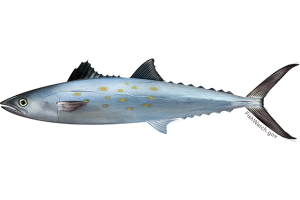
This Spanish Mackerel has the distinct finlets of the mackerel family along the dorsal and ventral side of the body.
Image: NOAA
Mackerel
When you mention mackerel around here you usually think of one of two fish – the king mackerel (sometimes just referred to as “the king”) and the Spanish mackerel. But it is actually a large family of open water fish that includes the tuna, bonito, and the wahoo (of baseball fame).
They are some of the fastest fish in the sea, and several species are ram-jetters. Sleek bodies, sharp angular fins, they can be identified by the row of small finlets on the dorsal and ventral sides of their bodies near the rear. Full of red muscle, rich in myoglobin (which can hold more oxygen than hemoglobin alone), these are powerful swimming fish and very popular in the sushi trade. A bluefin tuna can be 14 feet long, 800 pounds, and bring a commercial fisherman tens of thousands of dollars. Because of this bluefin tuna are internationally protected and managed.
Another cool thing about these guys is that some species can control blood flow, and location, to help maintain a higher body temperature – “warm blooded” – allowing them to venture into colder waters of the world’s oceans. They are one of the big migratory fish we find. Following the large ocean currents, some species use this to play out their entire life cycle. Born in the warmer portions of the ocean gyres, they grow and feed in the cooler areas, returning in the warmer currents to breed.
There are 12 species in this family ranging in size from 1 to 15 feet. They have the characteristic “dark on top – light one bottom” coloration many animals have. This called countershading. It is believed to be used as a form of camouflage in the deep blue – with the darker blue-indigo on top (to blend in with the bottom if look from above) and the lighter silver-white on the bottom (to blend in with the sunlit surface if viewed from the below). This idea was used by the US Navy during World War II. If you visit our Naval Aviation Museum, you will see they painted the planes a darker blue on top and a lighter white on bottom. In hopes that the Japanese pilots would have a hard time spotting them over the Pacific Ocean. It is also believed to help with temperature control. The darker side will absorb heat, while the lighter side releases – avoiding over-heating. Amazing fish, aren’t they?
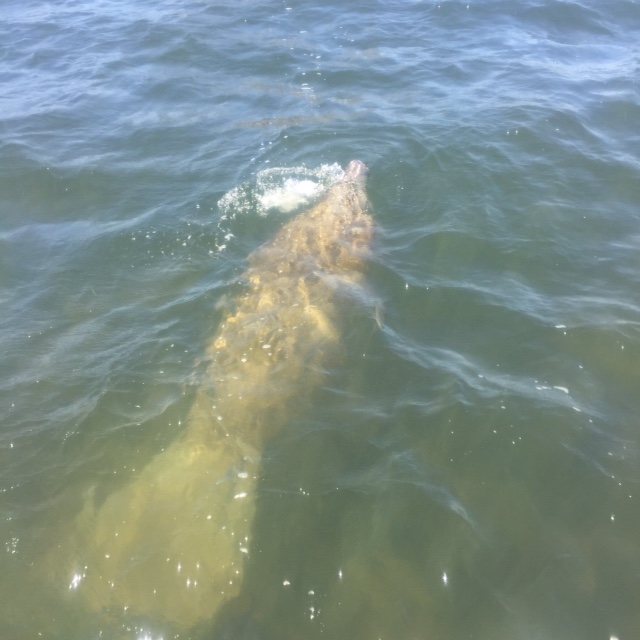
by Rick O'Connor | Aug 13, 2020
Mammals are historically land-based, or terrestrial, animals. They are quadrupeds (four legs) and run with a cursorial form of locomotion (backbone moving up and down) – some are the fastest land animals the planet has ever seen. But as fate would have it, some returned to the sea and occupied niches there. They are so well designed for a life in water that even look like fish. However, they differ in several ways:
1) Their tail extends horizontally instead of vertically and moves in an up and down motion instead of a side to side.
2) They of course lack scales, but they lack the characteristic hair of mammals as well. Though some hair may be found if you look close enough, they use blubber (layers of fat) to keep their bodies warm instead. Due to their warm blooded-ness, many do very well in cold parts of the ocean.
3) They also have mammalian lungs – not gills. Amazingly they exchange almost 90% of the air in their lungs with each breath (compared to about 20% for humans). With this huge load of oxygen, they remain underwater for long periods of time and dive to deep depths. The record would belong to the sperm whale who can dive to depths of 3000 feet for up to 90 minutes!
4) And of course, they give live birth nurturing the developing fetus with a placenta and feeding the developing young with milk from their mammary glands – this is not found in fish.
There are three orders of marine mammals: The Cetaceans (whales and dolphins), Pinnipeds (seals and sea lions), and Sirenians (manatees and dugongs). All three were once found in the Gulf of Mexico. Today there are only cetaceans and sirens, the lone pinniped (the Caribbean Monk Seal) is now believed to be extinct.
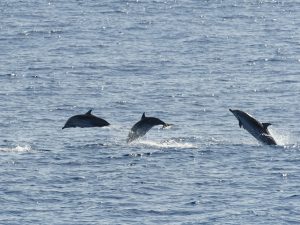
A group of small dolphin leap from the ocean.
Photo: NOAA
Dolphins
The Atlantic Bottlenose Dolphin (Tursiops truncatus) is the most common dolphin seen by visitors in our area. This lively, playful, and intelligent creature is the one most often seen at aquarium shows. Dolphins are whales, just small ones, and belong to a group known as “toothed whales”. They have numerous conical canine-type teeth used for grabbing fish and squid. Lacking molars, they cannot chew – so they must select prey they can either cut into smaller pieces, or swallow whole as is.
The toothed whales are known for their ability to detect prey using a form of SONAR called echolocation. Sound pulses are produced by flaps of skin within the blowhole (the nostrils of the dolphin) and exit the animal through a blob of fat in the head called the melon. Low frequency clicks can travel farther and find the targets, high frequency clicks have smaller range but can tell the dolphin what type of fish it is, and some whales can even produce high enough frequencies to literally “stun” their prey in the water – making it easier to grab. These “echo’s” or “clicks” are usually above (or below) our hearing range.
Dolphins are very social animals, traveling in large groups called pods. The pods are typically made of adult females and young, though there are one or two males. They communicate with each other using sound. The sounds are produced from the larynx in the blowhole area and are distinct for each pod. Outside dolphins are usually not allowed within the pod, so dolphins are not always the friendly creatures we perceive them to be – at least to each other.
When mom gives birth to a single calf (though very rare, twins have occurred) she rolls while swimming forward to expel the young – who must quickly surface for it’s first breath. The other females in the pod usually help with this. The baby suckles milk from hidden mammary glands which the mom exposes with the calf nudges her side. The calves stay with their moms for about two years learning the tricks of the trade before the cycle begins again.
These are truly amazing animals. Read more about dolphins at:
https://www.fisheries.noaa.gov/species/common-bottlenose-dolphin.
https://www.dolphincommunicationproject.org/index.php/the-latest-buzz/the-dolphin-pod/item/94419-how-does-echolocation-work.
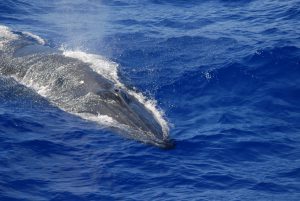
The large head and double blowhole of a Bryde’s whale.
Photo: NOAA
Whales
Though dolphins are whales, there are many others. The order Cetacea is broken into two suborders – the toothed whales (Odontoceti – which includes the dolphins) and the baleen whales (Mysteiceti). There are at least 20 species of whales and dolphins reported from the Gulf of Mexico – only one of those is a baleen whale, the Bryde’s Whale. Mammals as a group are known as heterodonts (meaning they have more than one type of tooth in their mouths). You, for example, have incisors, canines, pre-molars, and molars. Whales and dolphins break this rule by being homodonts. The toothed-whales and dolphins have conical canine teeth. Baleen whales have a fibrous hair-like material in their upper jaw that is stiff like the bristles of a toothbrush called baleen. The whale swallows seawater and then pushes it through the baleen trapping small shrimp and fish which they lick down their throats.
Whales are known for their long migrations – some of the longest in the animal kingdom. Their thick blubber and large size allow them to survive in polar waters – where much of their food is found. However, their babies are smaller (albeit 5-10 feet small) and they are not prepared for such cold waters. So, mom must migrate to tropical waters to give birth – fatten the baby up with some of the richest milk in the mammal group – and migrate back so she can feed herself. To navigate they use sound, the Earth’s magnetic field, and their eyes to do so. Whales can produce very low frequency sounds that can travel thousands of miles across the ocean echoing off objects that may be familiar to them. They also have magnetite in their retinas that allow them to pick up the Earth’s magnetic field, much the same as a compass does. And scientists also believe the act of spyhopping, where a whale will stop – turn vertical in the water – and extend their head above the surface – is in fact checking landmarks to aid them.
As with dolphins – these are amazing animals. Read more at:
https://aquatic.vetmed.ufl.edu/services/stranding-response/marine-animals-of-the-gulf-of-mexico/.
https://www.fisheries.noaa.gov/species/brydes-whale.
http://www.pbs.org/kqed/oceanadventures/episodes/whales/indepth-navigation.html.
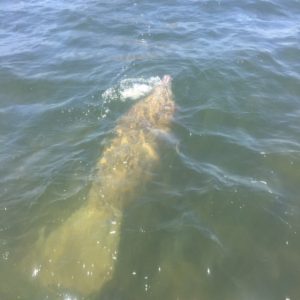
Manatee swimming in Big Lagoon near Pensacola.
Photo: Marsha Stanton
Manatees
“Mermaids”… at least that was what Christopher Columbus thought when he reached the new world. I guess they have that body shape… I guess. These are marine mammals but are not related to whales and dolphins. Instead, their closest living relatives are elephants. This is because mammals are divided into orders based on the type, and number, of teeth they have – and manatee teeth are nothing like dolphins. They have square shaped molars with ridges on the upper surface for grinding plant material – they are vegetarians. Most herbivores, like horses, have large incisors that can cut the grass and then move them back to their gnawing molars. Manatees lack these incisors. Instead they use their large lips, much the same as an elephant uses its trunk, to extend – and grab the grass, pulling it from the bottom of the bay and then gnawing with those big molars.
The differ from dolphins in other ways:
1) Their fluke (tail) is more round than forked – and they travel MUCH slower.
2) They lack a blow hole – but do still have nostrils. They are positioned closer to where ours are so they must extend part of their head out of the water in order to breath.
3) Though some whales lack dorsal fins – all manatees do.
4) They also do not tolerate polar waters very well. There was one species – the Stellar Sea Cow – that lived in Alaska, but this animal was MUCH larger than the tropical manatee – large size allows you to maintain a higher body temperature. It is now extinct – hunted out by fishermen as a food source while fishing. The animal was actually named after one of them – Captain Georg Stellar.
5) They are also not as social – manatees are usually loners except during breeding season and gathering in warm springs during the winter.
That said, they are migrators as well. They will venture out during the warm months to seagrass beds in the north – including Pensacola Beach – returning to the warm springs of central Florida, or the tropical waters of south Florida, in the winter. Navigation, in their case, is a bit easier – they are coastal – manatees do not travel out to sea as whales and dolphins do. They slide along the coastline, eating as they go, enjoying the sun, and avoiding boats. Locally we see them along the Gulf side, in the Intracoastal, and even up into the bays and bayous of Pensacola Bay as they move from Mobile Bay to and from central Florida.
WE DO HAVE A CITIZEN SCIENCE REPORTING PROGRAM FOR THIS ANIMAL.
If you see one contact Sea Grant Agent Rick O’Connor (roc1@ufl.edu ). We would like to know – exactly where you saw it, date you saw it, time you saw it, was it alone, and which direction was it traveling.
As with other marine mammals – manatees are amazing to see and can be the highlight of your visit. We ask that while boating, when you approach shore please slow speed and (if possible) have a spotter looking to make sure you do not hit one of these charismatic creatures.
Read more at:
https://www.fws.gov/refuge/Crystal_River/wildlife_and_habitat/Florida_Manatee.html.
https://www.savethemanatee.org/manatees/migration/.
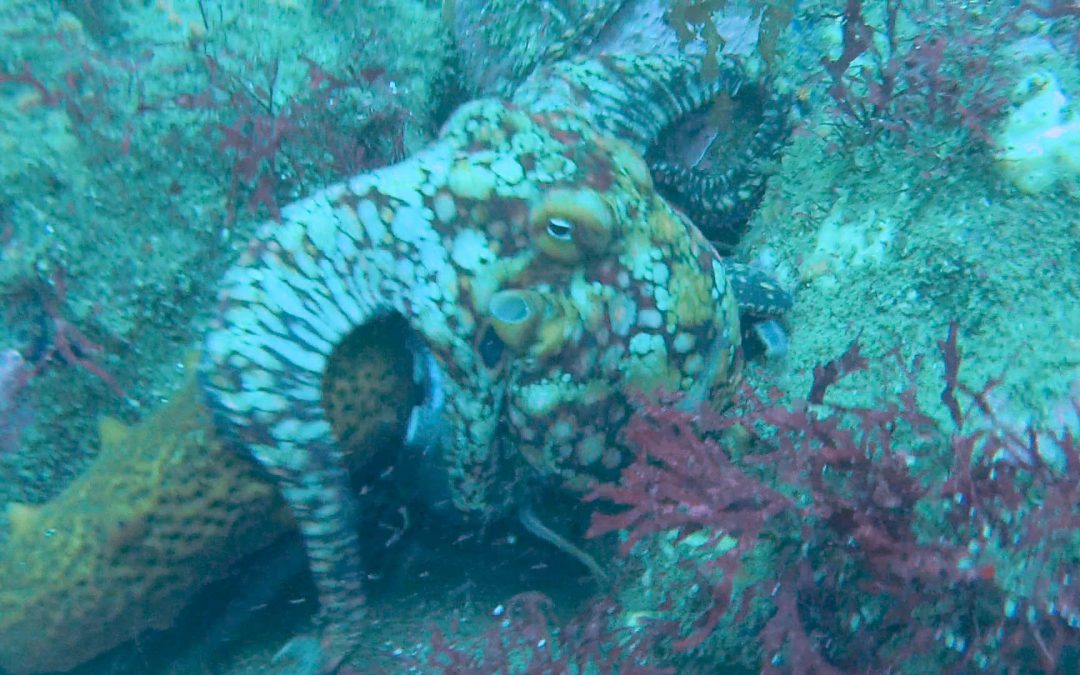
by Rick O'Connor | Jul 7, 2020
For many of the blogs we have posted on marine life of the Gulf of Mexico I have used the term “amazing” – but these cephalopods are truly amazing. There have been numerous nature programs featuring not just marine invertebrates but rather highlighting the cephalopods specifically. We have been amazed by their looks, their colors, their intelligence, and their ferocity. They are the animals of ancient mariner legends – the “kraken”.
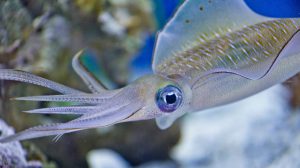
These are not your typical mollusk. The elongated body and lack of external shell changes everything for cephalopods.
Photo: California Sea Grant
But for us who just visit the beach to play and walk – we rarely see them. They are quite common. The squid are almost transparent in the water column as they swim and usually run deep until nighttime. The only ones I have ever encountered were hauled up in shrimp trawls – but they are usually hauled up each time, and sometimes in great numbers. Octopus are more nighttime roamers as well. I have occasionally seen them diving during daylight hours, but they are very secretive and well camouflaged. I have found cephalopods both in the Gulf and within the estuaries – again, they are more common than we think.
A study conducted in the 1950s logged 42 species within the Gulf of Mexico. Many of them live in the open sea and at depths of 350-500 feet. There are actually four types of cephalopods – the octopus and squid we know, the cuttlefish and nautilus less so because they are not common in the Gulf region.
They are mollusk but differ from their snail and clam cousins in that they have very little, if any shell. The nautilus is an ancient member of this group and still possess an external shell. However, it is chambered and can be filled with gas like a hot air balloon allowing the nautilus to hover off the seafloor – something their snail/clam cousins can only dream about.
The squid and cuttlefish have reduced their shell to a surfboard looking structure that is found internally, serving almost like backbone. It allows them some rigidity in the water column, and they can grow to greater size. Actually, the squid are the largest invertebrates on the planet, with the “giant squid” (Architeuthus) reaching lengths of 50 feet or more.
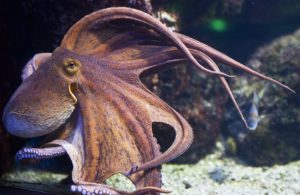
The octopus differs from the squid in that it lacks a shell all together. Thus, it is smaller and lives on the ocean floor.
Photo: University of South Florida
The octopus lack a shell all together. Without this rigid bone within, they cannot reach the great size of the giant squid – so giant octopus are legend. However, there is a large one that grows in the Pacific that has reached lengths of 30 feet and over 500 pounds – big enough!
The lack of a shell means they must defend themselves in other ways. One is speed. With no heavy shell holding you down, high speed can be achieved. Again, squid are some of the fastest invertebrates in the ocean – being clocked at 16 mph. This may not outrun some of the faster fish and marine mammals, and many fall victim to them. Birds are known to dive down and eat large numbers of them. But they can counter this by having chromatophores. These are cells within the skin filled with colored pigments that they can control using muscles. This allows them to change color and hide. And their ability to change color is unmatched in the animal kingdom. I recommend you find some video online of the color change (particularly of the cuttlefish) and you will be amazed. Yes… amazed.
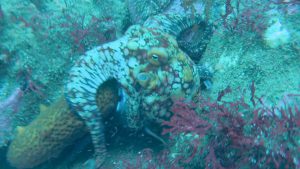
The chromatophores allow the cephalopods to change colors and patterns to blend in.
Photo: California Sea Grant
To control such color, they must have a more developed brain than their snail/clam cousins – and they do. The large brain encircles their esophagus and not only be used to ascertain the colors of the environment (and how to blend in) but also has the capability of learning and memory. The octopus in particular has been able to solves some basic problems – to escape, or get food from a closed jar, for example. Many of these chromatophores possess iridocytes – cells that act has mirrors and enhance the colors – again, amazing to watch.
All cephalopods are carnivorous and hunt their prey using their well-developed vision. Squid prefer fish and pelagic shrimp. Octopus are inclined to grab crustaceans and other mollusk – though they will grab a fish when the opportunity presents itself. Cephalopods hunt with their tentacles – which are at the “head end” of the body. The squid possess eight smaller arms and two longer tentacles. Each have a series of sucker cups and hooks to grab the prey. They keep their tentacles close to their bodies and, when within range, quickly extend them grabbing the fish and bringing back to the mouth where a sharp parrot-like beak is found. They bite chunks of flesh off and some have seen them bite the head off a mackerel. I was bitten on the hand by a squid once – one of the more painful bites I have ever had.
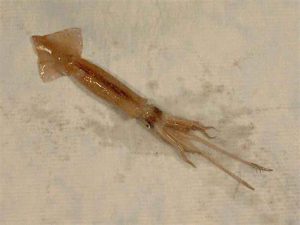
The extended tentacles of this squid can be seen in this image.
Photo: NOAA
The octopus does not have the two long tentacles – rather only the eight arms (hence its name). They move with stealth and camouflage (thanks to the chromatophores) sneaking up on their prey – or lying in wait for it to come close. Here things change a bit. Octopus possess a neurotoxin similar to the one found in puffer fish. They can bite the crab – inject the venom – which includes digestive enzymes similar to rattlesnakes and spiders – and ingest the body of the semi-digested prey after it dies. They can drill holes into mollusk shells and inject the venom within. Most will give a painful bite but there is one in the Indo-Pacific (the blue-ringed octopus) whose venom is potent enough to kill humans.
Making new octopus and squids involves the production of eggs. The male will deposit a sac of sperm called a spermatophore into the body of the female. She will then fertilize her eggs and excrete them in finger like projections that do not have hard shells. Squid usually die afterwards. Octopus will remain with the eggs – oxygenating and protecting them until they hatch. At which time they will die.
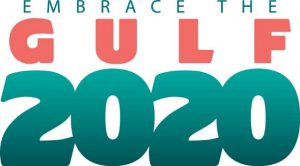
Though we have a variety of cephalopods near shore – the real grandeur is offshore. Out there are numerous species of bioluminescent cephalopods – most living at 500 feet during the day and coming within 300 feet at night. Many swim, while some float, others have developed a type of buoyant case they can carry their eggs in. Far too much to go into in a blog such as this one. I recommend you do a little searching and learn more about these amazing animals.
Enjoy the Gulf!
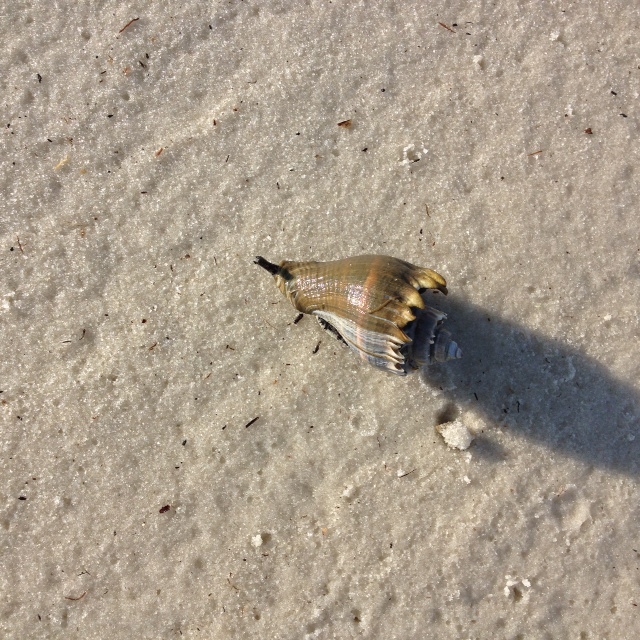
by Rick O'Connor | Jun 11, 2020
One of the largest groups of invertebrates in the Gulf are the Mollusk… what many call “seashells”. Shell collecting has been popular for centuries and, in times past, there were large shows where shells from around the world were traded. Almost everyone who visits the beach is attracted to, and must take home, a seashell to remind them of the peace beaches give us. Many are absolutely beautiful, and you wonder how such small simple creatures can create such beauty.
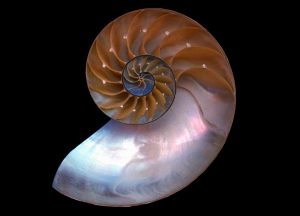
One of the more beautiful shells from the sea – the nautilus.
Photo: Wikipedia
Well, first – not all mollusk are small. There are cephalopods that rival the size of some sharks and even whales.
Second, many are not that simple either. Some cephalopods are quite intelligent and have shown they can solve problems to reach their food.
But beautiful they are, and the colors and shapes are controlled by their DNA. Just amazing.
There are possibly as many as 150,000 different species of mollusks. These species are divided into 8-9 classes (depending which book you read) but for this series on Embracing the Gulf we will focus on only three. First up – the snails (Class Gastropoda).
There are an estimated 60,000 – 80,000 species of gastropods, second only to the insects. They are typically called snails and slugs and are different in that they produce a single coiled shell. The shell is made of calcium carbonate (limestone) and is excreted from tissue called the mantle. It covers their body and continues to grow as they do. The shell coils around a linear piece of shell called the columella. Most coil to the right, but some to the left – sort of like right and left-handed people. There is an opening in the shell where the snail can extend much of its body – this is called the aperture – and some species can close this off with a bony plate called an operculum when they are inside. Some snail shells have a thin extension near the head that protects the siphon – a tube that acts like a snorkel drawing water in and out of the body.
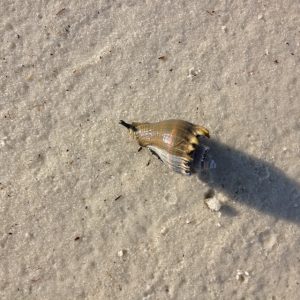
The black siphon can be seen in this crown conch crawling across the sand.
Photo: Franklin County Extension.
They have pretty good eyes and excellent sense of smell. They possess antenna, which can be tactile or sense chemicals in the water (smelling) to help provide information to a simple brain.
They are slow – everyone knowns this – but they really don’t care. Their thick calcium carbonate shells protect them from most predators in the sea… but not all.
Their cousins the slugs either lack the shell completely, or they have a remnant of it internally. You would think “what is the point of an internal shell?” – good question. But the slugs have another defense – they are poisonous. Venomous and poisonous are two different things. Being poisonous means you have a form of toxin within your body tissue. If a predator eats you – they will get very sick, maybe die. But you die as well, so… Not too worry, poisonous slugs are brightly colored – a universally understood signal to all predators.
There is one venomous snail – the cone snail, of which we have about five species in the Gulf. They possess a stylet at the tip of their siphon (similar to the worms we have been writing about) which they can use as a dart for prey such as fish. Many gastropods are carnivores, but some are herbivores, and some are scavengers.
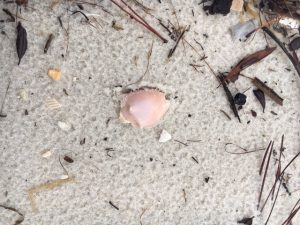
Many shells are found on the beach as fragments. Here you see the fragment of a Florida Fighting Conch.
Photo: Rick O’Connor
Most have separate sexes and exchange gametes in a sack called a spermatophore. Fertilized eggs are often encased in structures that resemble clusters, or chains, of plastic. These are deposited on the seafloor and the young are born with their shell ready for life.
This group is not as popular as a food item as other mollusk but there are some. The Queen Conch is probably of the most famous of the edible snails, and escargot are typically land snails. I am not aware of any edible slugs… and that is good thing.
Some of the more common snails you will find along our portion of the Gulf of Mexico are:
Crown Conch Olive Murex Banded Tulip
Whelks Cowries Bonnets Cerith
Slippers Moon Oyster Drills Bubble
The most encountered slug is the sea hare.
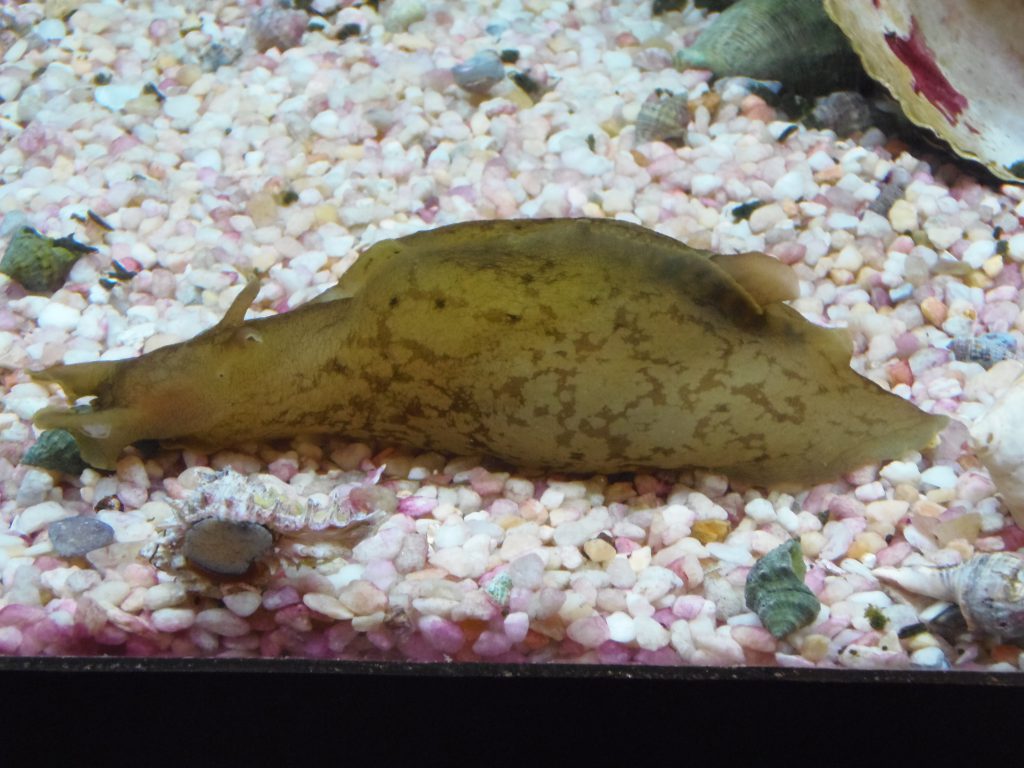
A common sea slug found along panhandle beaches – the sea hare.
I hope you get a chance to do some shelling – I hope you find some complete ones. It is addictive!





























